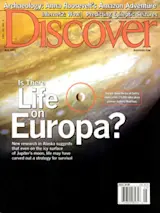Survival First Your article "Can We Find Another Earth?" [March] is a wonderful discussion of the remarkable science sponsored by NASA that may soon allow us to find a new Earth. However, the last paragraph of the article implies that the end point of the program is finding out whether life exists on some other Earth-like planet. Human curiosity about the possibility of life elsewhere is a side issue that should not in any way distract from the goal of survival of Earth's miraculous life system. We must focus on how we can carry elements of Earth's life to a new Earth and thus double its chances of survival in the universe.
William J. Sauber—Gulf Shores, Alabama
In Your Dreams The interview with Bill Domhoff [Discover Dialogue, March], in which he questions whether dreams have a function or a purpose, left me feeling annoyed. Dreaming, like sleep, is a necessity ...














